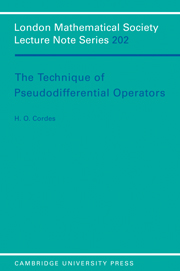Book contents
- Frontmatter
- Contents
- Preface
- Chapter 0 Introductory discussions
- Chapter 1 Calculus of pseudodifferential operators
- Chapter 2 Elliptic operators and parametrices in ℝn
- Chapter 3 L2-Sobolev theory and applications
- Chapter 4 Pseudodifferential operators on manifolds with conical ends
- Chapter 5 Elliptic and paraolic problems
- Chapter 6 Hyperbolic first order systems
- Chapter 7 Hyperbolic differential equations
- Chapter 8 Pseudodifferential operators as smooth operators of L(H)
- Chapter 9 Particle flow and invariant algebra of a semi-strictly hyperbolic system; coordinate invariance of Opψxm.
- Chapter 10 The invariant algebra of the Dirac equation
- References
- Index
Chapter 9 - Particle flow and invariant algebra of a semi-strictly hyperbolic system; coordinate invariance of Opψxm.
Published online by Cambridge University Press: 09 February 2010
- Frontmatter
- Contents
- Preface
- Chapter 0 Introductory discussions
- Chapter 1 Calculus of pseudodifferential operators
- Chapter 2 Elliptic operators and parametrices in ℝn
- Chapter 3 L2-Sobolev theory and applications
- Chapter 4 Pseudodifferential operators on manifolds with conical ends
- Chapter 5 Elliptic and paraolic problems
- Chapter 6 Hyperbolic first order systems
- Chapter 7 Hyperbolic differential equations
- Chapter 8 Pseudodifferential operators as smooth operators of L(H)
- Chapter 9 Particle flow and invariant algebra of a semi-strictly hyperbolic system; coordinate invariance of Opψxm.
- Chapter 10 The invariant algebra of the Dirac equation
- References
- Index
Summary
Introduction
We use the natural symbol classes Ψx, x=1, s, in this chapter. First we ask for invariance of Opipx under global coordinate transforms. Each ΨGX is invariant under conjugation with T∈ GX. For a subgroup these are linear coordinate transforms: For GT get the translations eZD, for GS the ‘similarities’ Tσo,z,0 (all distances multiplied by a constant), for GL get all linear substitutions. Another subgroup gives ‘gauge transforms’ (conjugation by eiξx).
The question about more general coordinate (or gauge-) invariance of ΨGX=ΨAX may be phrased as follows: ΨGX is the set of A∈ L(H) with At=eLtAe−Lt∈ C∞ (ℝ,L(H)) for every L∈ AX. in new coordinates y=φ(x) the folpdes L∈ AX will transform to other folpdes L∼ forming a Lie algebra AX∼, where L∼ v=g, v=u0φ−1, g=f0φ−1 Clearly eLt transforms to e L∼t, as solution operator of ∂tu=Lu ↔ ∂tv=L∼v. Thus “A∈ ΨGX” means A∼t=etL∼ Ae−tL∼ ∈ C∞ (ℝ,L(H)), assuming that u(x)→u∼ (x)=u(φ(x)) defines an isomorphism of H. Thus, in new coordinates the property “A∈ VGX” transforms to smoothness under certain eLt, with more complicated L∈ AX∼, depending on φ.
Vice versa, since a coordinate transform is invertible, “A∈ ΨGX” (that the transformed operator is in ΨGX) may be expressed as smoothness of eMt Ae−Mt for certain M – the transforms of L∈ AX back to the old coordinates. For coordinate invariance we must show that eMtAe−Mt∈ C∞ (ℝ,L(H)) for the transforms M of pq or ηpq.
- Type
- Chapter
- Information
- The Technique of Pseudodifferential Operators , pp. 282 - 309Publisher: Cambridge University PressPrint publication year: 1995



